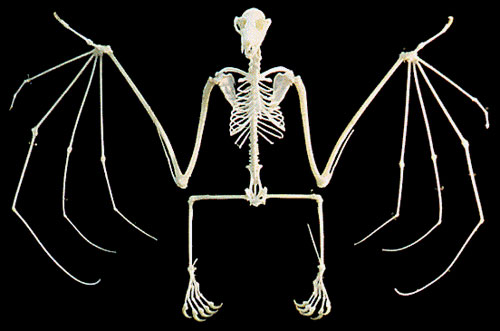



Chiroptera: More on Morphology
Bats are well adapted for powered flight, and these adaptations show in the skeleton. Some of these adaptations are analogous to those seen in the other two groups of flying vertebrates, the pterosaurs and birds. To delve further into this subject, check out our new exhibits on vertebrate flight and chiropteran flight.
Bat bones tend to be light and slender (which accounts in part for the sparse fossil record of bats). As in birds, bats have some reduced bones; note in
 |
Like most birds and pterosaurs, bats have a keel on the sternum, or breastbone, to which the large flight muscles attach. Unlike birds and pterosaurs, in which the wing is supported by the bones of the arm and one finger, a bat's wing membrane, or patagium, is supported by the arm and by four highly elongated fingers (hence the name Chiroptera, or "hand-wing," for the bats). The patagium extends all the way around to the bat's hind legs and tail, where it forms a flap called the uropatagium, supported by specialized foot bones called calcars. Not only does the uropatagium help the bat fly and maneuver, it is often used to sweep prey, such as insects on the wing, into the bat's mouth while the bat is in flight.
The first digit of the bat wing (homologous to our thumb) is small and clawed, and bats can use it to climb or to walk on the ground. Contrary to popular belief, bats are not helpless on the ground or in the water, and some insectivorous species feed on ground-dwelling insects as much or more than they feed on insects captured in flight.
The Megachiroptera, or fruitbats and flying foxes, navigate largely by sight and have large, forward-facing eyes that can see in very dim light, as you can see on the skeleton of a fruitbat pictured above. Microbats have smaller eyes (although they are not blind) and navigate by "sonar" or echolocation, producing pulses of high-pitched sound and navigating by listening for the echos. Thus microbats often have large ears, which are unbelievably sensitive. Many microbats, like the one depicted at left, also have fleshy growths around the mouth and nose area, giving them a rather grotesque appearance — thus certain species are known as "leaf-nosed bats," "bulldog bats," "flower-faced bats," "horseshoe bats," and so on. These growths appear to function in directing and controlling the ultrasound pulses that the bat sends out, so that the bat can "scan" a wide or a narrow area.
For the latest cutting-edge research on bat sonar and echolocation, visit the Bat Research Laboratory at Purdue University, Indianapolis, Indiana.
Bat skeleton image by Ben Waggoner.
